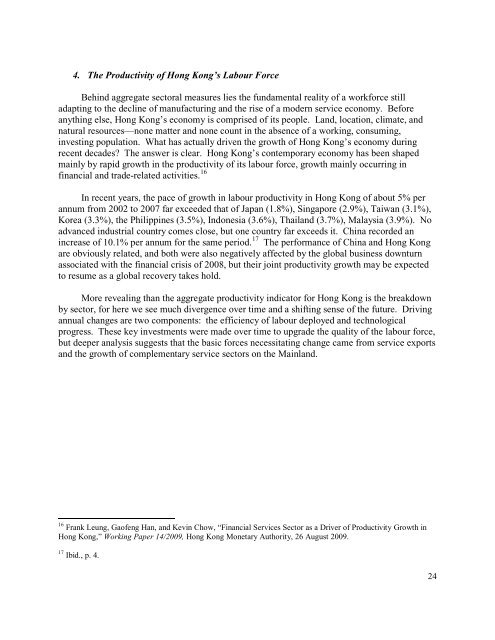Hong Kong's International Financial Centre: Retrospect and Prospect
Hong Kong's International Financial Centre: Retrospect and Prospect
Hong Kong's International Financial Centre: Retrospect and Prospect
You also want an ePaper? Increase the reach of your titles
YUMPU automatically turns print PDFs into web optimized ePapers that Google loves.
4. The Productivity of <strong>Hong</strong> Kong’s Labour Force<br />
Behind aggregate sectoral measures lies the fundamental reality of a workforce still<br />
adapting to the decline of manufacturing <strong>and</strong> the rise of a modern service economy. Before<br />
anything else, <strong>Hong</strong> Kong’s economy is comprised of its people. L<strong>and</strong>, location, climate, <strong>and</strong><br />
natural resources—none matter <strong>and</strong> none count in the absence of a working, consuming,<br />
investing population. What has actually driven the growth of <strong>Hong</strong> Kong’s economy during<br />
recent decades? The answer is clear. <strong>Hong</strong> Kong’s contemporary economy has been shaped<br />
mainly by rapid growth in the productivity of its labour force, growth mainly occurring in<br />
financial <strong>and</strong> trade-related activities. 16<br />
In recent years, the pace of growth in labour productivity in <strong>Hong</strong> Kong of about 5% per<br />
annum from 2002 to 2007 far exceeded that of Japan (1.8%), Singapore (2.9%), Taiwan (3.1%),<br />
Korea (3.3%), the Philippines (3.5%), Indonesia (3.6%), Thail<strong>and</strong> (3.7%), Malaysia (3.9%). No<br />
advanced industrial country comes close, but one country far exceeds it. China recorded an<br />
increase of 10.1% per annum for the same period. 17<br />
The performance of China <strong>and</strong> <strong>Hong</strong> Kong<br />
are obviously related, <strong>and</strong> both were also negatively affected by the global business downturn<br />
associated with the financial crisis of 2008, but their joint productivity growth may be expected<br />
to resume as a global recovery takes hold.<br />
More revealing than the aggregate productivity indicator for <strong>Hong</strong> Kong is the breakdown<br />
by sector, for here we see much divergence over time <strong>and</strong> a shifting sense of the future. Driving<br />
annual changes are two components: the efficiency of labour deployed <strong>and</strong> technological<br />
progress. These key investments were made over time to upgrade the quality of the labour force,<br />
but deeper analysis suggests that the basic forces necessitating change came from service exports<br />
<strong>and</strong> the growth of complementary service sectors on the Mainl<strong>and</strong>.<br />
16 Frank Leung, Gaofeng Han, <strong>and</strong> Kevin Chow, “<strong>Financial</strong> Services Sector as a Driver of Productivity Growth in<br />
<strong>Hong</strong> Kong,” Working Paper 14/2009, <strong>Hong</strong> Kong Monetary Authority, 26 August 2009.<br />
17 Ibid., p. 4.<br />
24


